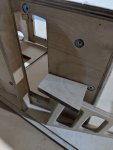First time really listening using the basic IIR filters Peter posted here
Sounds wonderful. Love the clarity on the high end and how the further away you get, the only thing that changes is volume, stays very sharp.
I'm on the very beginning of the learning curve when it comes to processing, so looking forward to making them sound even better.

@Peter Morris - I pm'ed you about your latest FIR filters, but here is probably better. I read through this thread and the 60 degree thread again, but the only filters I am seeing are these.
1. Sounds like there are newer ones? Are they posted somewhere and I'm missing it?
2. For someone new like me, where should I be getting started when it comes to doing my own measurements? This thread has been super informative, enjoying learning from you all.
Sounds wonderful. Love the clarity on the high end and how the further away you get, the only thing that changes is volume, stays very sharp.
I'm on the very beginning of the learning curve when it comes to processing, so looking forward to making them sound even better.

@Peter Morris - I pm'ed you about your latest FIR filters, but here is probably better. I read through this thread and the 60 degree thread again, but the only filters I am seeing are these.
1. Sounds like there are newer ones? Are they posted somewhere and I'm missing it?
2. For someone new like me, where should I be getting started when it comes to doing my own measurements? This thread has been super informative, enjoying learning from you all.



